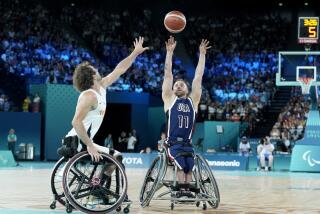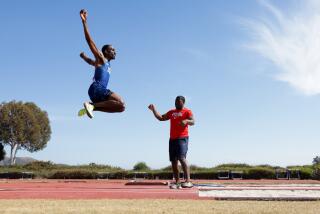Wild Wompin’ : Action Is Fast, Furious in Wheelchair Rugby Tournament
- Share via
They used to call it “murderball,” but a lot of players thought there should be more emphasis on the finesse involved.
“It’s not like getting out there and totally womping on people,” insisted one participant in a six-team quadriplegic rugby tournament, held over the weekend in Claremont.
But there was, nevertheless, plenty of womping going on in the Claremont High School gym on Sunday, the last day of the three-day tournament that attracted teams from as far away as Berkeley and San Jose.
The players, all of them paralyzed from spinal cord injuries with their upper body mobility hampered in varying degrees, used their wheelchairs like battering rams to power across the goal lines. They set brick-wall picks or rattled their opponents with flying blocks. Sometimes, they even spilled their opponents onto the floor in a tangle of spokes and limbs.
“Just about everybody here has muscle pulls, cuts, scratches, bruises, or bumps,” said Darrel Ray, a wily forward for the host team, the Casa Colina Raiders of nearby Pomona, surveying the weary crowd of athletes late Sunday.
In the torrid final minute of a game against the San Jose Sting, Ray himself tottered precariously, then hit the ground in a messy spill.
“Me and Dino got involved in the war of the worlds out there,” Ray said after the game, nodding toward his friend and opponent Dino Wallen.
“Your wheel came up on my foot,” said Wallen, a brawny 250-pounder, who provides most of the muscle for the Sting.
Ray laughed.
“I was trying to roll over him,” he said.
The Raiders had been two goals behind with a minute to play. After the spill, they scored once on a nifty Ray pass, then the 43-year-old television writer started cutting through a snarl of wheelchairs, clutching the ball with one hand. He was a foot from the goal line when the final buzzer sounded.
The Raiders lost 20 to 19.
“I was one push away,” said a disgusted Ray.
The idea of the sport is to carry the ball--a volleyball--across the goal line more times than your opponents do in four eight-minute quarters. There are four players to a team, with varying degrees of disability.
“You don’t want the game to be dominated by the guys with the upper-body mobility,” says Sherrie Burlo, coach of two teams from Casa Colina, a rehabilitation hospital in Pomona renowned for its wheelchair athletics program.
Players can rush around the court with the ball on their laps, provided they pass or dribble every 10 seconds. But the referees can send them to a penalty box for such rule violations as holding. Players spend much of the game milling around the goal line, with the ball carrier looking for an opening as wheelchairs grind against each other.
“It’s the first sport that quads are really able to participate in,” said Dave Kiley, director of the Casa Colina Wheelchair Sports Program.
“Quads tend to be pampered a lot,” says Burlo, a recreation therapist. “Most of them come out of the hospital, and they can’t do a whole lot. So a lot of people do-do-do for them, until they learn how to use the equipment.”
But participation in athletics tends to make them more self-sufficient.
“The guys out here aren’t pampered,” Burlo said.
The top teams from the weekend tournament--the Berkeley Quadzilla, the San Jose Sting--will play in a national championship tournament in San Diego next month.
The Casa Colina Raiders have to play one more game to qualify as a wild card contender.
The sport, invented by three Canadian quadriplegics eight years ago, is growing rapidly in the United States, where it was introduced just two years ago.
It is also attracting more and more women. These are people like Luz Ayala, a special education teacher from Los Angeles. Her team, the Clash, went up against the Santa Barbara Breakers on Sunday.
Time and again, Steve Pate, the star of the Santa Barbara team who was eventually declared the tournament’s most valuable player, spun around Clash blockers, zigzagging nimbly across the goal line.
But Ayala, playing with a look of controlled fury on her face, stopped him a few times, backing her wheelchair into his path, working with teammates to block the goal line, letting the side of her wheelchair collide with the attacker. Then she scored a few goals herself, cutting past blockers or passing off to teammates.
“I like earning the respect of the guys,” said Ayala, the only woman on her team. “You got to show them what you got.”
Some members of the Berkeley Quadzilla attribute their success to the fact that four out of 12 members of the team are women.
“People say, ‘Aw, they got all those women out there,’ ” said Allen Seals. “Then Annie (teammate Ann Cupolo) puts a pick on you.”
Therapists like to talk about the value of wheelchair sports in fostering self-esteem. But the athletes say they’re playing for keeps.
“The only difference between us and any other athletes,” said Wallen, a veteran wheelchair athlete who has won the Boston Marathon twice, “is that we’ve got wheels under our butts.”
More to Read
Go beyond the scoreboard
Get the latest on L.A.'s teams in the daily Sports Report newsletter.
You may occasionally receive promotional content from the Los Angeles Times.










